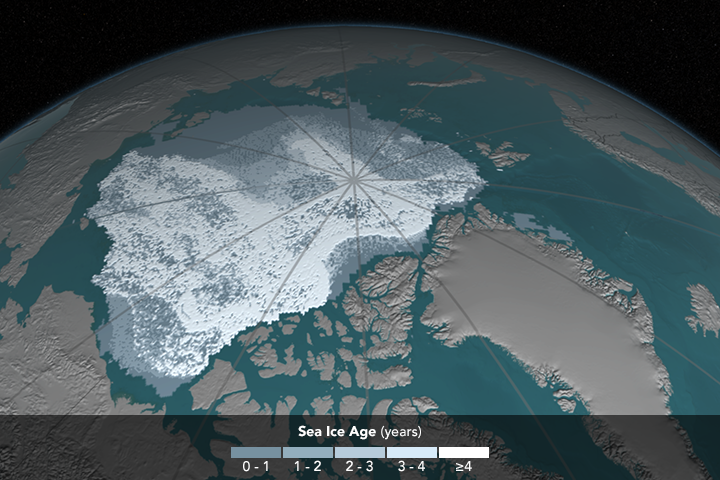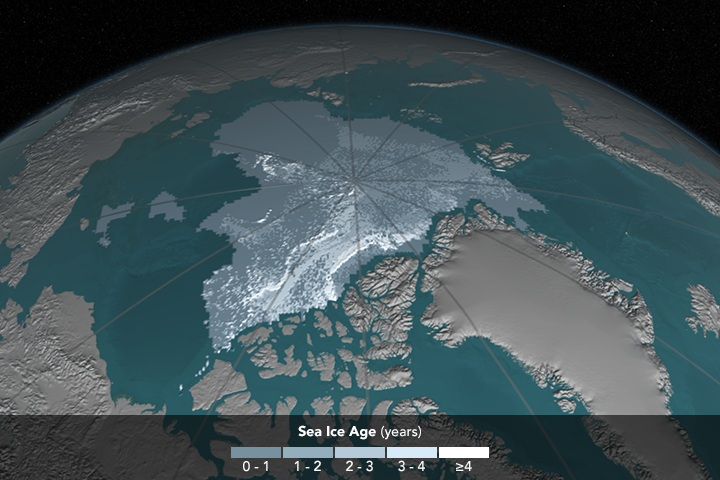



Every year, we report on the melting and growth of Arctic sea ice, the vast sheet of frozen seawater floating on the Arctic Ocean and its neighboring seas. Much attention is focused on the area and extent of sea ice because it has been shrinking steadily. But there is another problem: As the ice extent has shrunk, the oldest and thickest ice has either thinned or melted away, leaving the sea ice cap more vulnerable to the warming ocean and atmosphere.
“What we’ve seen over the years is that the older ice is disappearing,” said Walt Meier, a sea ice researcher at NASA’s Goddard Space Flight Center. “This older, thicker ice is like the bulwark of sea ice: a warm summer will melt all the young, thin ice away but it can’t completely get rid of the older ice. That bulwark is not as good as it used to be. The older ice is becoming weaker because there is less of it, and the remaining ice is more broken up and thinner.”
The visualizations above and the animation below show how Arctic sea ice has been growing and shrinking, spinning, melting in place, and drifting out of the Arctic for the past three decades. The age of the ice is represented in shades of blue-gray to white, with the brightest whites representing the oldest ice. In September 1984, there were 1.86 million square kilometers of old ice (4 years or older) spread across the Arctic at its yearly minimum extent. In September 2016, there were only 110,000 square kilometers of older sea ice left.
“We have lost most of the older ice: In the 1980s, multi-year ice made up 20 percent of the sea ice cover; now it’s only about 3 percent,” Meier added. “The older ice was like the insurance policy of the Arctic sea ice pack. As we lose it, the likelihood for a largely ice-free summer in the Arctic increases.”
Direct measurements of sea ice thickness have been sporadic and incomplete across the Arctic, so scientists have developed estimates of ice age. “Age is a good analog for thickness because as ice gets older it gets thicker,” said Meier. “This is due to the ice generally growing more in the winter than it melts in the summer.”
The visualizations are based on data from drifting buoys, weather stations, computer models, and 12 satellites (mostly passive microwave instruments) that have made measurements over the past four decades. Passive microwave instruments measure brightness temperature, the microwave energy emitted by sea ice due to its temperature, salinity, surface texture, and the amount of snow on top of it. Each ice floe has a characteristic brightness temperature, so researchers developed a way to identify and track ice floes in successive microwave images as they moved across the Arctic.
“It’s like bookkeeping. We are keeping track of sea ice as it moves around, up until it melts in place or leaves the Arctic,” said Meier. The analysis and modeling of sea ice age first began in the 1980s at the University of Colorado, and the dataset is now maintained by the National Snow and Ice Data Center.
The animation shows two main bursts of old ice loss. The first one, starting in 1989 and lasting a few years, was due to a switch in the Arctic Oscillation, which shrank the Beaufort Gyre and enhanced the Transpolar Drift Stream, thereby flushing more sea ice out of the Arctic than usual. The second surge in ice loss started in the mid-2000s.
“What’s happening now is that more old ice is melting within the Arctic Ocean during the summertime,” said Meier. “One of the reasons is that the multi-year ice used to be a pretty consolidated ice pack, and now we’re seeing relatively smaller chunks of old ice interspersed with younger ice. These isolated floes of thicker ice are much easier to melt.”
Read more about sea ice in our newly updated fact sheet.NASA maps and animation by Cindy Starr, NASA Scientific Visualization Studio. Caption by Maria-Jose Vinas, NASA Earth Science News Team.